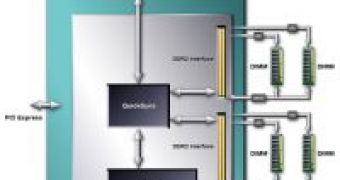In the middle of the battle for market shares, processor price and power efficiency and just about everything else, AMD is trying to outmaneuver its rival in the very market segment where Intel reigns supreme because of its Xeon quad core processor family. Simply put, AMD is going to double the total memory handling capabilities of its upcoming processors, jumping from the standard 8 memory modules per processor that are in use today in Opteron and Xeon based servers to 16 memory modules.
This new technology that should support such a dramatic memory increase is called G3MX and according to sources from AMD cited by the news site TGDaily, it will address the increasing need of memory on high performance and time critical multi-socket servers that are running applications like databases and virtualization software which require a large amount of memory and processing power. It seems that AMD is designing this new memory technology to be used in server systems with four or more processors, but they "could imagine" it being used even on smaller systems like dual processor servers and workstations, according to TGDaily.
As the DDR3 memory standard gains wide spread acceptance and the DDR2 one is showing signs of fatigue, AMD decided to design the new memory controllers used in the G3MX technology to be DDR3 compliant only. They should be available for use in server systems along side the new Barcelona quad core processors. On the other side of the fence, Intel already jumped high over the 8 memory module limit, as the new Tigerton Xeon 7300 processor will support up to huge 32 memory modules.
The downside of Intel's memory controller technology is that they are not using standard DDR2 or DDR3 memory, but the more expensive FB-DIMMs that are more power hungry than standard memories are and work only at higher latencies. From this point of view, Intel is at a disadvantage even when compared with the Opteron processor.

 14 DAY TRIAL //
14 DAY TRIAL //